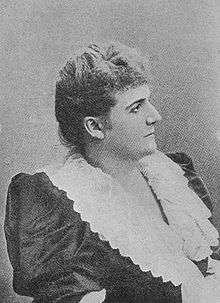Augusta Holmès

Augusta (Mary Anne) Holmès (18 December 1847 – 28 January 1903) was a French composer of Irish descent (her father was from Youghal, Co. Cork). At first she published under the pseudonym Hermann Zenta. In 1871, Holmès became a French citizen and added the accent to her last name.[1] She herself wrote the lyrics to almost all her songs and oratorios, as well as the libretto of her opera La Montagne Noire and the programmatic poems for her symphonic poems including Irlande and Andromède.
Biography
Holmès was born in Paris.[2] Despite showing talent at the piano, she was not allowed to study at the Paris Conservatoire, but took lessons privately. She developed her piano playing under the tutelage of local pianist Mademoiselle Peyronnet, Versailles' cathedral organist Henri Lambert, and Hyacinthe Klosé. Also, she showed some of her earlier compositions to Franz Liszt. Around 1876, she became a pupil of César Franck, whom she considered her real master.[2] (She led the group of Franck's students who in 1891 commissioned for Franck's tomb a bronze medallion from Auguste Rodin.[3])
Camille Saint-Saëns wrote of Holmès in the journal Harmonie et Mélodie: "Like children, women have no idea of obstacles, and their willpower breaks all barriers. Mademoiselle Holmès is a woman, an extremist." Like other female composers from the nineteenth century including Fanny Mendelssohn and Clara Schumann, Holmès published some of her earlier works under a male pseudonym ("Hermann Zenta") because women in European society at that time were not taken seriously as artists and discouraged from publishing.
For the 1889 celebration of the centennial of the French Revolution, Holmès was commissioned to write the Ode triomphale for the Exposition Universelle, a work requiring about 1,200 musicians. She gained a reputation of being a composer of programme music with political meaning, such as her symphonic poems Irlande and Pologne.
Personal life
%2C_Claudine_(1876%E2%80%931937)%2C_and_Helyonne_(1879%E2%80%931955).jpg)
Holmès never married, but she cohabited with the poet Catulle Mendès; the couple had five children, including:[4]
- Huguette Mendès (1871–1964)
- Claudine Mendès (1876–1937)
- Helyonne Mendès (1879–1955)
Holmès bequeathed most of her musical manuscripts to the Paris Conservatoire.
Selected compositions

Operas
- Héro et Leandre (1875) opera in one act[2]
- Lancelot du lac, opera in three acts (unpublished)
- La Montagne noir, opera in four acts (1885), Paris, Opéra, 8 Feb 1895
Cantatas
- Astarté, poème musical (1871, unpublished)
- Lutèce, symphonie dramatique (1877)
- Les Argonautes, symphonie dramatique (1880)
- Ludus pro patria, ode-symphonie (1888)
- Au pays bleu, suite symphonique (c.1888)
- Une Vision de Sainte Thérèse for soprano and orchestra (c.1888)
- Ode triomphale en l'honneur du centenaire de 1789 (1889)
- Hymne à la paix (1890)
- Hymne à Apollo (c.1890s)
- La Belle au bois dormant suite lyrique (1902)
- La Vision de la reine, cantata
Orchestral works
- Ouverture pour une comédie, symphonic poem (before 1870)
- Roland furieux (1876)
- Irlande, symphonic poem (1882)
- Andromède, symphonic poem (1883)
- Pologne, symphonic poem (1883)
Piano music
- Rêverie tzigane (1887)
- Ce qu'on entendit dans la nuit de Noël (1890)
- Ciseau d'hiver (1892)
Songs, Song Collections
(selective list)
- Les Sept ivresses: 1. L'Amour; 2. Le Vin; 3. La Gloire; 4. La Haine; 5. Le Rêve; 6. Le Désir; 7. L'Or (1882)
- Trois Chansons populaires: 1. Mignonne; 2. Les Trois pages; 3. La Princesse (1883)
- Noël: Trois anges sont venus ce soir (1884)
- En Chemin (1886)
- Hymne à Eros (1886)
- Fleur de neige (1887)
- La Chanson de gas d'Irlande (1891)
- Berceuse (1892)
- Contes divines (1892-5): 1. L'Aubepine de Saint Patrick (1892); 2. Les Lys bleus (1892); 3. Le Chemin de ciel (1893); 4. La Belle Madeleine (1893); 5. La Légende de Saint Amour (1893); 6. Les Moutons des anges (1895)
- Noël d'Irlande (1896)
References
- ↑ Augusta Holmès: A Meteoric Career Rollo Myers The Musical Quarterly, Vol. 53, No. 3 (Jul., 1967), page 365. "Her surname was Gallicized by the addition of a grave accent on its last syllable."
- 1 2 3 Arthur Elson (1903) Woman's work in music, The Page Company, Boston, digitized by Google.
- ↑ Daniele Gutmann, "Rodin et la Musique", in: Revue Internationale de Musique Française, February 1982, p. 105.
- ↑ "Auguste Renoir | The Daughters of Catulle Mendès, Huguette (1871–1964), Claudine (1876–1937), and Helyonne (1879–1955) | The Met". metmuseum.org. The Metropolitan Museum of Art. Retrieved 13 February 2017.
Bibliography
- Rollo Myers: "Augusta Holmès: A Meteoric Career", in: The Musical Quarterly 53 (1967) 3, pp. 365–76
- Gérard Geffen: Augusta Holmès, l'outrancière (Paris: P. Belfond, 1987) ISBN 2-7144-2153-9
- Karen Henson: "In the House of Disillusion: Augusta Holmès and La Montagne noir", in: Cambridge Opera Journal 9 (1997) 3, pp. 232–62
- Michèle Friang: Augusta Holmès ou la gloire interdite (Paris: Éditions Autrement, 2003) ISBN 2746702983
- Nicole K. Strohmann: Gattung, Geschlecht und Gesellschaft im Frankreich des ausgehenden 19. Jahrhunderts: Studien zur Dichterkomponistin Augusta Holmès (Hildesheim: Georg Olms, 2012) ISBN 978-3-487-14701-7
- Mariateresa Storino: ""Chère Illustre": Franz Liszt ad Augusta Holmès, in: "Quaderni dell'Istituto Liszt" 9 (2010), pp. 1-44